Scroll Ecosystem Overview

Key Insights
- Scroll leverages zero-knowledge proofs technology to enhance network efficiency, scalability, and transaction affordability, aligning with other successful solutions utilizing this technique.
- With a diverse ecosystem comprising various applications and protocols, such as AAVE and Pencils Protocol, Scroll aims to provide a comprehensive platform for DeFi activities.
- The introduction of the SCR token, allocated strategically across governance, proving, and sequencing mechanisms, further strengthens Scroll's ecosystem and decentralization journey.
What is Scroll
Scroll is an EVM equivalent Layer 2 solution for Ethereum, focusing on security, faster transactions and scaling theEthereum network.
Scroll is built on zero-knowledge proofs (ZK) technology, which has already proven its effectiveness on other solutions.
Scroll is powered by zkEVM (zero-knowledge Ethereum Virtual Machine), which significantly increases network throughput and reduces transaction costs.
Scroll has received $80M investment from leading venture capital funds such as Polychain Capital, IOSG Ventures, Bain Capital, Variant, Robot Ventures and others.
Zero-Knowledge Proofs
Zero-knowledge proofs (ZKPs) is a cryptographic technique that is used to prove the correctness of certain data without revealing the data itself.
This technique has become popular in L2 rollups because it makes transactions much cheaper and increases blockchain bandwidth without compromising security.
Using zero-knowledge proofs, a blockchain participant can perform a computation and then generate a proof that the computation was performed correctly.
Other participants in the network can verify that the calculation is correct by ensuring that the generated proof is valid, rather than having to re-run the calculation themselves using their own computer power.
zkEVM
Zero-knowledge Ethereum Virtual Machine is a virtual machine responsible for executing smart contracts on L2. It works in such a way that these smart contracts are compatible with zk proofs and the underlying L1 blockchain and its VM (in this case Ethereum).
The zkEVM is the consensus mechanism for Scroll that provides fast sending of transaction proofs without the need to store and send additional information.
Main Components and Key Features of Scroll
The Main Components of Scroll
Settlement Layer
Provides data availability and structuring for the Scroll chain, verifies validity proofs, and allows users and applications to exchange assets and messages between Ethereum and Scroll. Scroll uses Ethereum as the Settlement Layer.
Sequencing Layer
Consists of an Execution Node, which is responsible for executing transactions sent to the Scroll sequencer and to the L1 bridge contract.
Execution Node produces Scroll blocks as L2 solutions. In addition to the Execution Node, there is a Rollup Noderesponsible for batching transactions, sending transaction and block information to Ethereum, and providing validity proofs to Ethereum.
Proving Layer
Designed for generating zkEVM validity proofs that check the correctness of L2 transactions, and for sending them to Rollup Node for further sending to Ethereum.
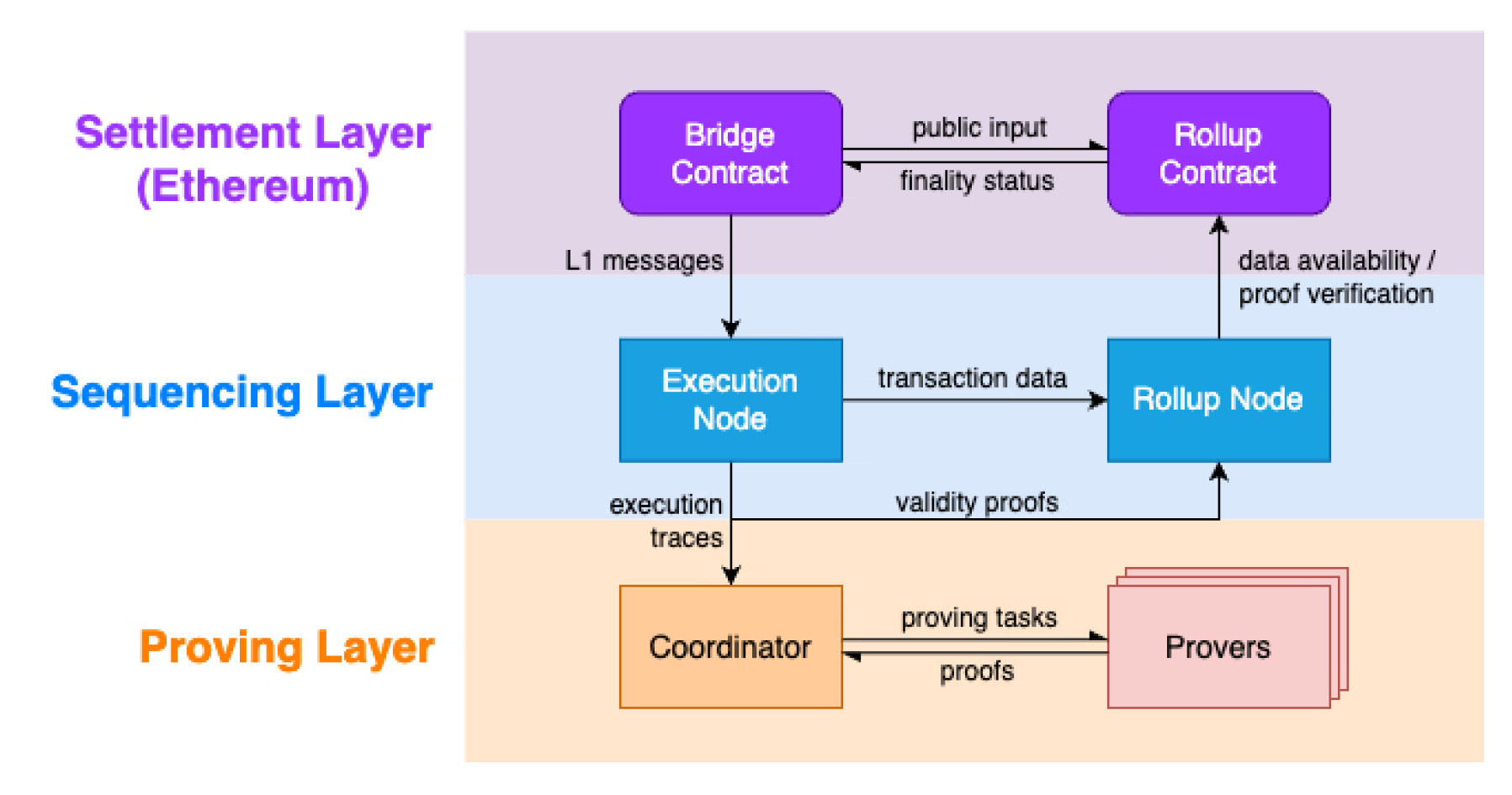
Key Features of Scroll
Zk-based rollup
As mentioned above, Scroll utilizes zero-knowledge proofs technology to increase network efficiency and Ethereum scaling, while providing the reliability and crypto-economic security guaranteed by the Ethereum infrastructure.
Cheaper transactions
Scroll offers users significantly cheaper transactions compared to Ethereum. The median transaction cost in Scroll is $0.051, while in Ethereum it is $2.07.
Ethereum Compatibility
Ethereum Virtual Machine compatibility makes it easier for Ethereum developers to run and work with protocols and applications on Scroll, making the blockchain more accessible and user-friendly.
Scroll: Fundamental Indicators
Number of active addresses
As of writing, Scroll ranks 4th among Ethereum Layer 2 in terms of active addresses (average for the last 7 days) with121K. The growth of active addresses for the year amounted to +790% and 128% for the last 30 days. Optimistic Rollup supported by Coinbase - Base with 1.68M active addresses is the leader by this indicator.

Number of transactions
Scroll ranks 5th among Ethereum L2 by the number of transactions on the blockchain (excluding system transactions). Scroll's average over the last 7 days is 741K transactions. The increase over the last 30 days is +244%, and +858% over a year. Base is also the leader with 6.33M daily transactions.
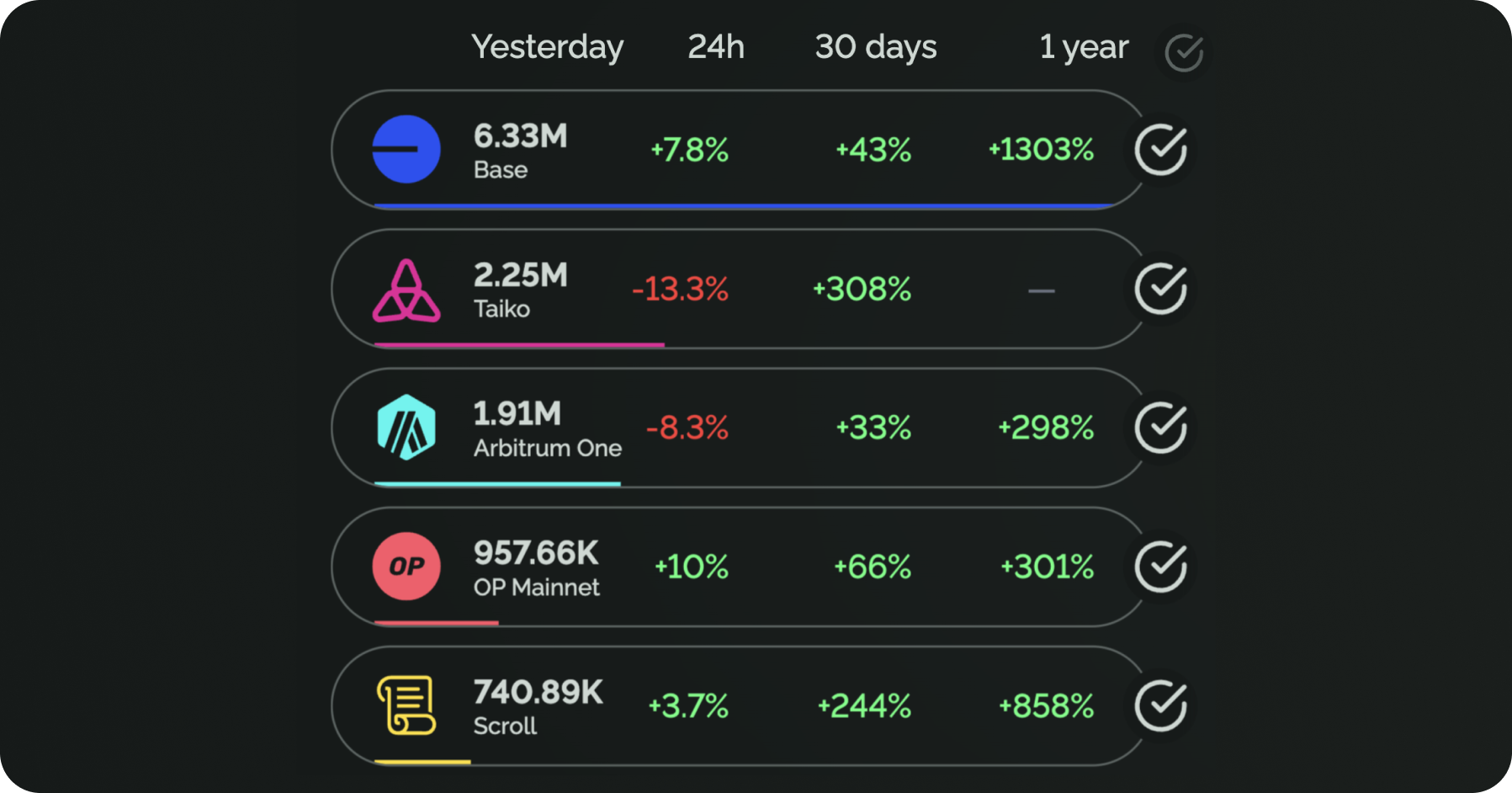
Transactions per second
Scroll also ranks 5th among L2 solutions in terms of TPS. The average TPS in the Scroll network is currently 8.58, which is the highest blockchain performance ever. However, Scroll's competitors are showing higher results. That being said, TPS of Base is 73.3, TPS of Taiko is 28.5, TPS of Arbitrum is 22. Ethereum, despite the high cost of transactions, exceeds the TPS of many L2 solutions, including Scroll with 14.4.
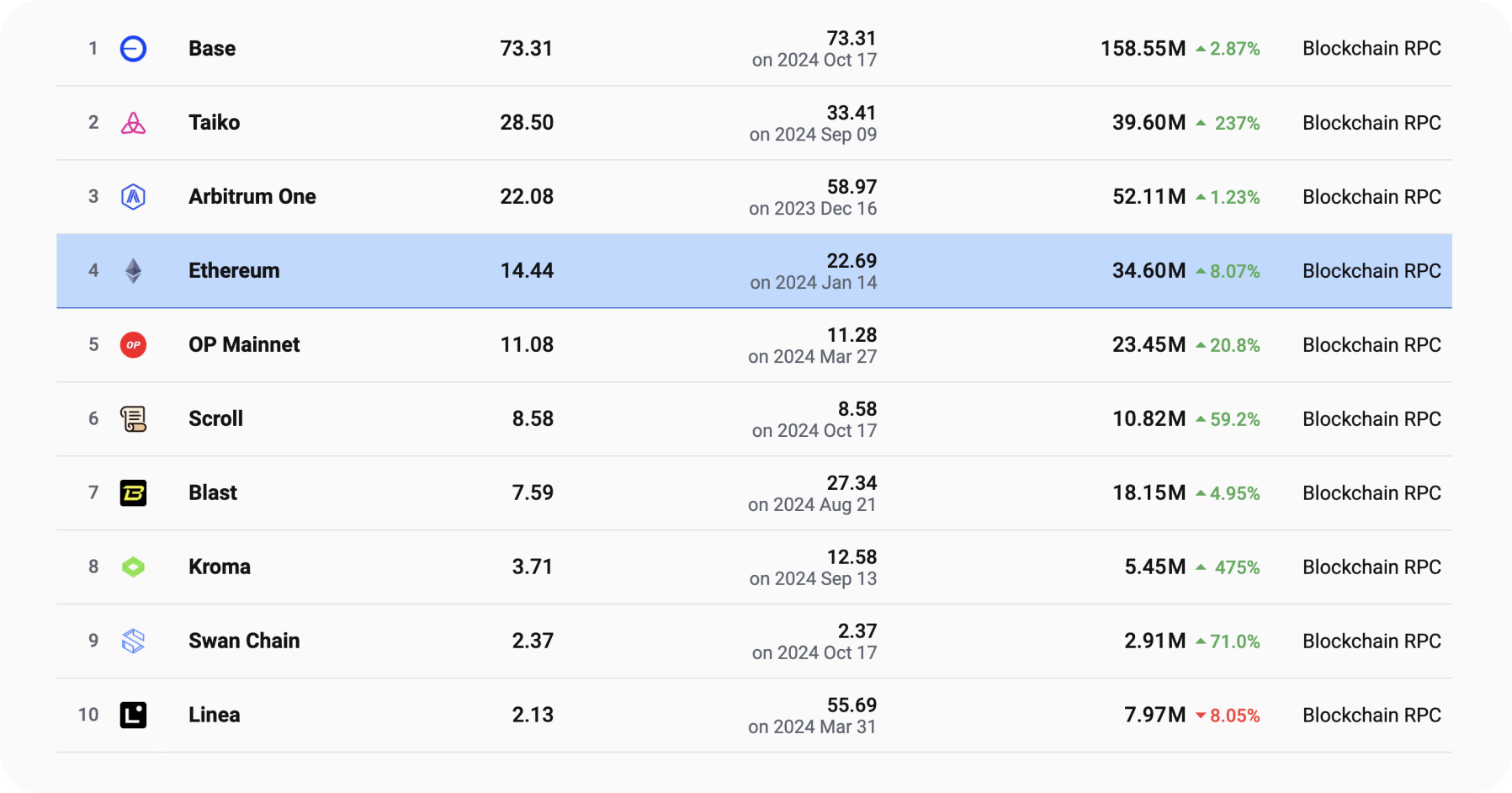
Onchain Economics
Over the last 90 days, Scroll's revenue totaled $1.65M, making it the 4th highest of all L2 solutions. Expenses amounted to $384K, total profit amounted to $1.27M. The project's rate of return over the last 90 days is 76.9%. By this indicator Scroll ranks 8th among L2 networks.
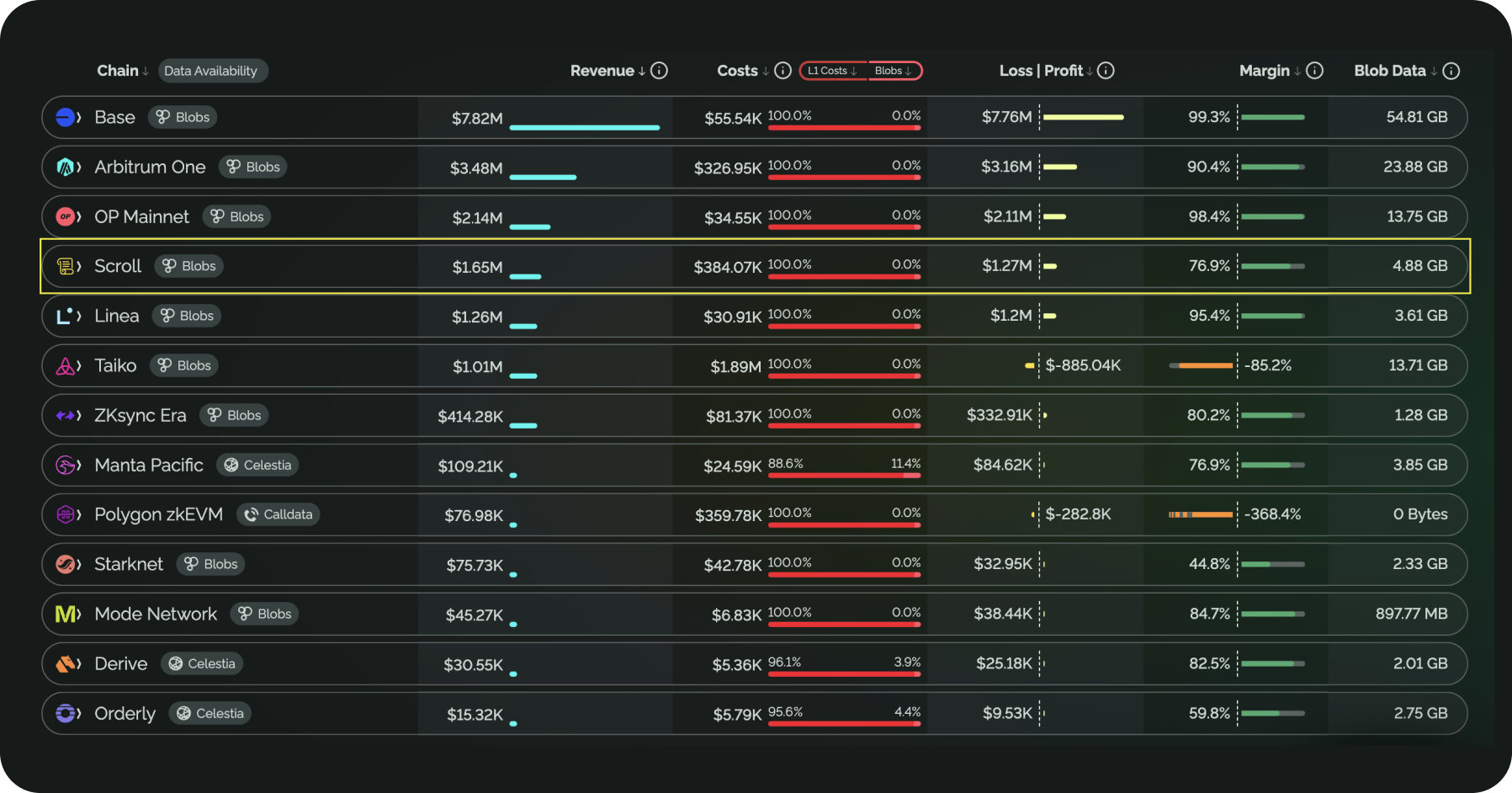
SCR Token
SCR is the primary utility token of the Scroll blockchain and its ecosystem used in governance. The launch of SCRmarks a new stage in Scroll's roadmap towards decentralization and improved user experience.
SCR will be used to decentralize key aspects of Scroll's operations, such as:
Governance
Scroll governance will be decentralized through the Scroll DAO. The SCR token will be used as the primary token for governance and voting for proposals to develop and improve Scroll.
Proving right
SCR will be used to create a sustainable network of provers as an economic reward for external participants.
Sequencing right
The sequencer organizes transactions and produces L2 blocks, which requires guarantees of performance and resilienceto censorship in real-time. SCR will be an integral part of this mechanism, guaranteeing that sequencers perform their work faithfully.
The total offering of the SCR token is 1,000,000,000,000,000 SCR. 15% of the supply is allocated to airdrop to active community members (7% on the first drop and another 8% on subsequent drops).
The largest portion of SCR tokens is allocated to the ecosystem and development, 35%, and 23% is allocated to the team and advisors, 17% to investors, and 10% allocated to the Scroll Foundation.
In general, the tokenomics of SCR does not have any peculiarities and is similar to the tokenomics of other projects. Notable is the large share of the team and investors, who together own 40% of the token supply.
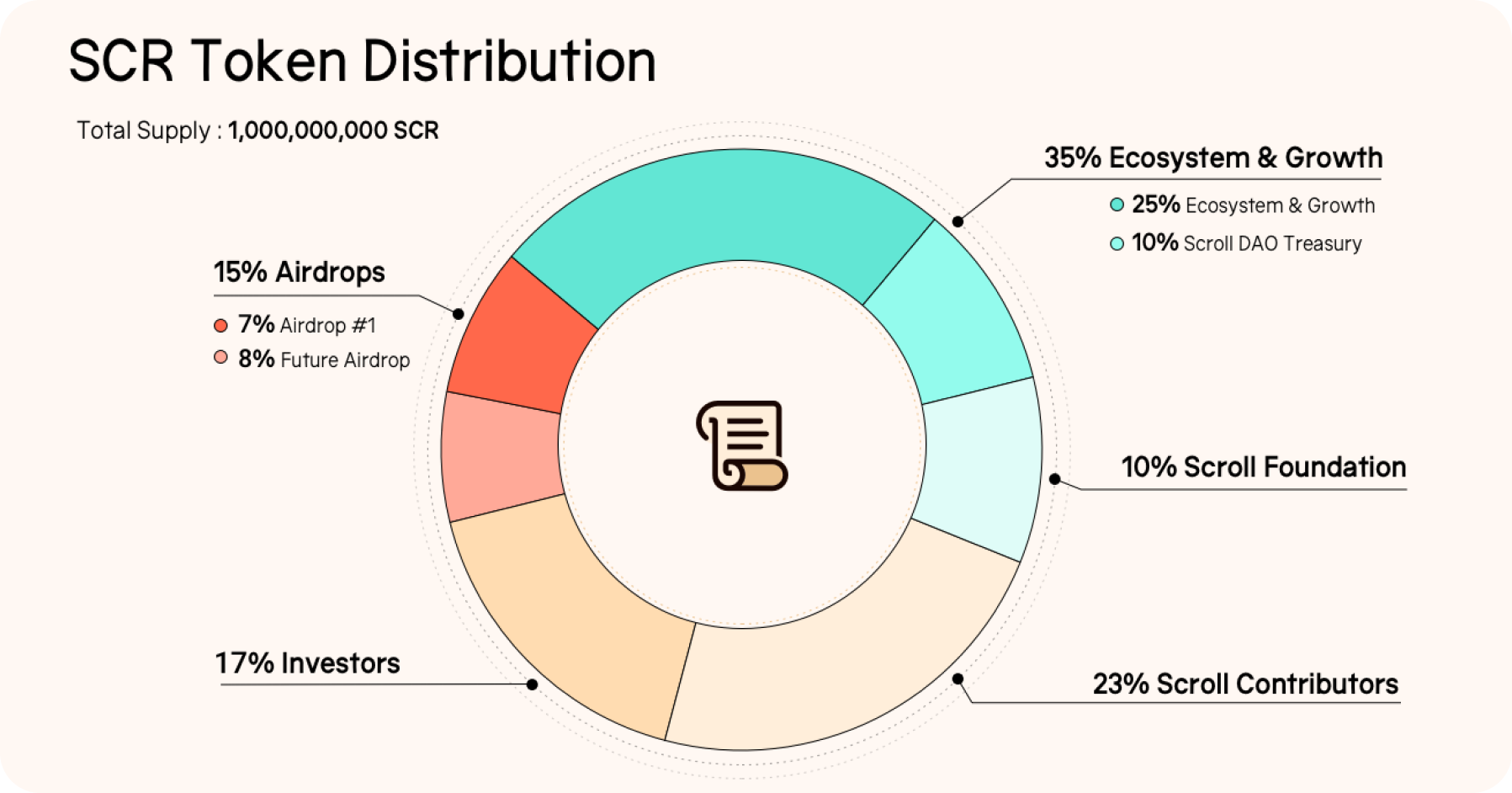
SCR was listed on leading exchanges including Binance on October 22, 2024. The token price after listing was ~$1.24and the circulating supply was 190M SCR (19% of the total supply). Scroll's current capitalization is $233.5M with an FDV valuation of $1.23B.
Along with the listing, active Scroll users were given the opportunity to claim an airdrop of SCR tokens. In total, about 571K wallets that fell under the minimum giveaway criteria can get the airdrop. The average drop for 200 marks (points that users earned for on-chain activity in Scroll) is about $30.
Scroll Ecosystem
Scroll has a well-developed ecosystem of different applications and protocols running on this blockchain. Currently, Scroll's TVL is $1.33B. According to DeFiLlama, there are about 100 DeFi protocols running on Scroll, including DEX, lending, derivative DEX, yield aggregators, and others.
AAVE
The leading DeFi protocol by TVL on Scroll ($437M). AAVE is a decentralized lending protocol offering non-custodial loans of crypto assets secured by other assets or additional returns from lending crypto assets to lending pools.
Pencils Protocol
A decentralized token launch platform and yield aggregator on Scroll, providing users with various strategies to increase yield. In addition, Pencils serves as a gateway for liquid asset staking/restaking on Scroll.
Pencils ranks second in the Scroll ecosystem in terms of TVL with $316M.
Tokan Exchange
Tokan is a liquidity layer and DEX built in the Scroll ecosystem. Tokan aims to provide exchanges with low fees and sustainable returns for liquidity providers. It ranks 3rd in the Scroll ecosystem with a TVL of $130M.
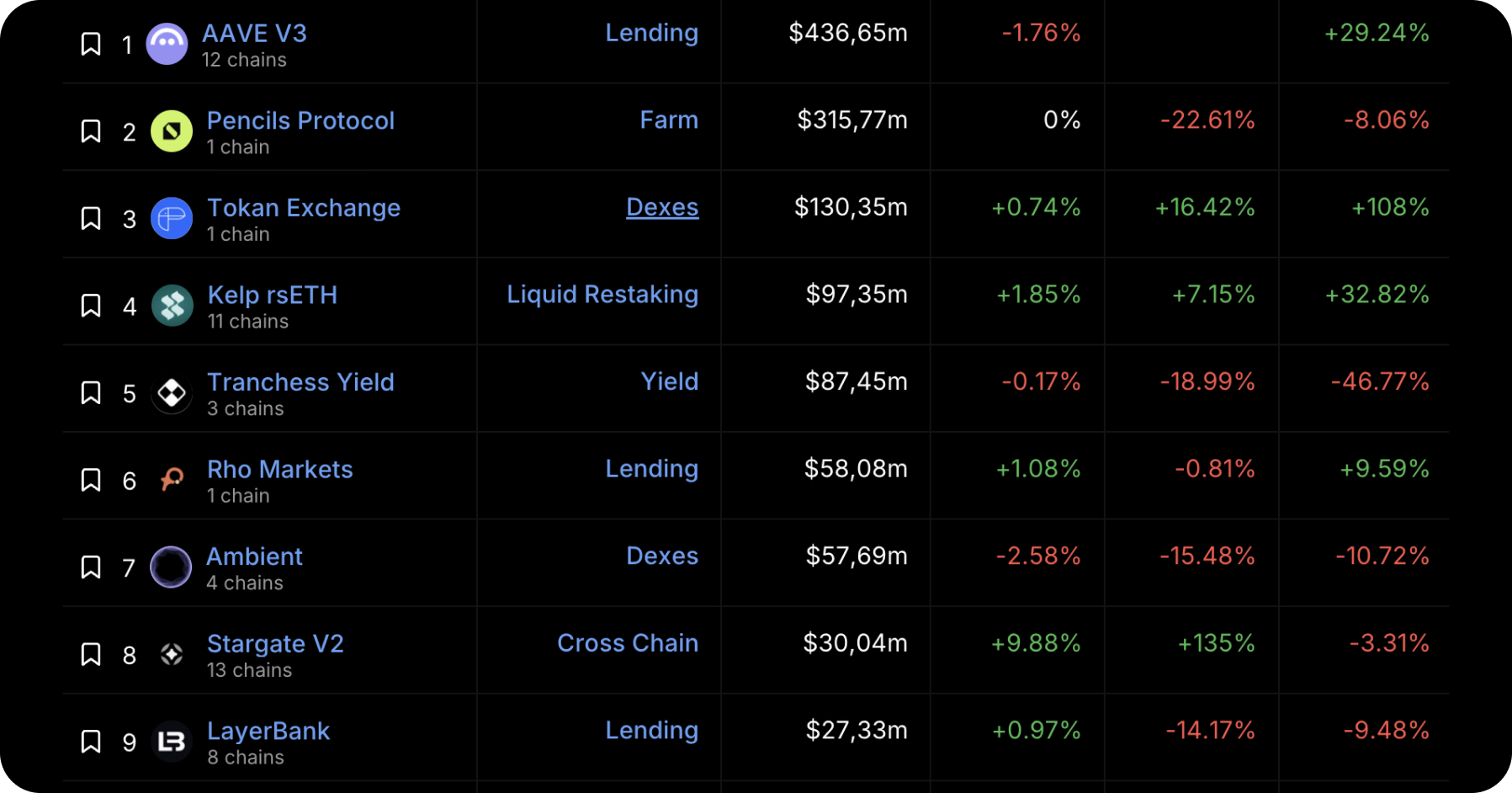
Scroll: Outlook
Scroll utilizes one of the most promising Ethereum scaling technologies, namely rollup, which uses ZK proofs in its operation. This makes the blockchain much cheaper to use and increases the speed of transaction execution.
L2 solutions will play an important role in the future of the Ethereum ecosystem, influencing its on-chain and economic performance.
On the other hand, the Layer 2 segment is highly competitive with pronounced leaders that hold a significant market share such as Base, Arbitrum, Optimism.
As the experience of launching new L2 solutions such as StarkNet, zkSync, Blast shows, they are not able to compete with the leaders and achieve comparable onchain performance.
In addition, activity on these networks was highly speculative and dropped significantly after airdrops were handed out. Scroll may face a similar problem, so it is important for the team to find a solution to keep users on the network and attract new audiences.
This can be achieved by introducing new interesting projects on Scroll and incorporating the network into popular narratives, such as the launch and trading of meme coins.
Users can get SCR or any other cryptocurrency for fiat or crypto on SimpleSwap.
Summary
Core components of Scroll include a Settlement Layer, Sequencing Layer, and Proving Layer, all powered by a zkEVM (zero-knowledge Ethereum Virtual Machine).
Some of Scroll's key features are cheaper transactions, Ethereum compatibility, and a growing ecosystem of DeFi protocols.
Scroll has received significant investment and is positioning itself as a competitive Layer 2 solution, though it faces challenges from established leaders in the space.
The article provides an overview of Scroll's technology, tokenomics, ecosystem, and future outlook. It highlights Scroll's potential to contribute to the evolution of the Ethereum ecosystem through its ZK-based rollup approach, while also noting the competitive landscape and the need for Scroll to differentiate itself and maintain user engagement.
The information in this article is not a piece of financial advice or any other advice of any kind. The reader should be aware of the risks involved in trading cryptocurrencies and make their own informed decisions. SimpleSwap is not responsible for any losses incurred due to such risks. For details, please see our Terms of Service.


